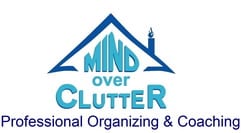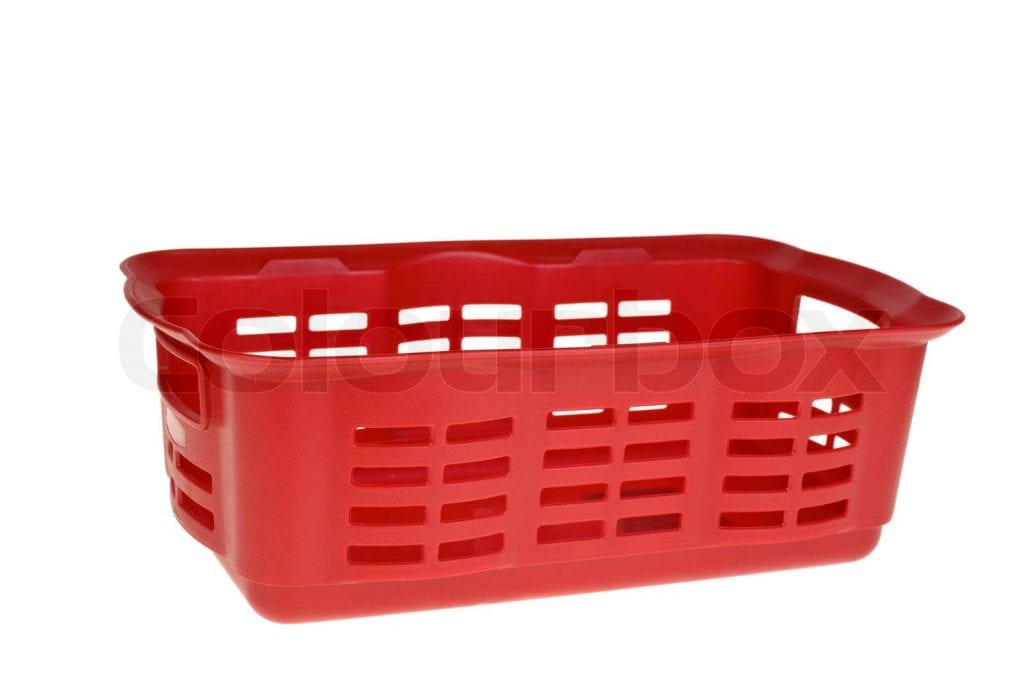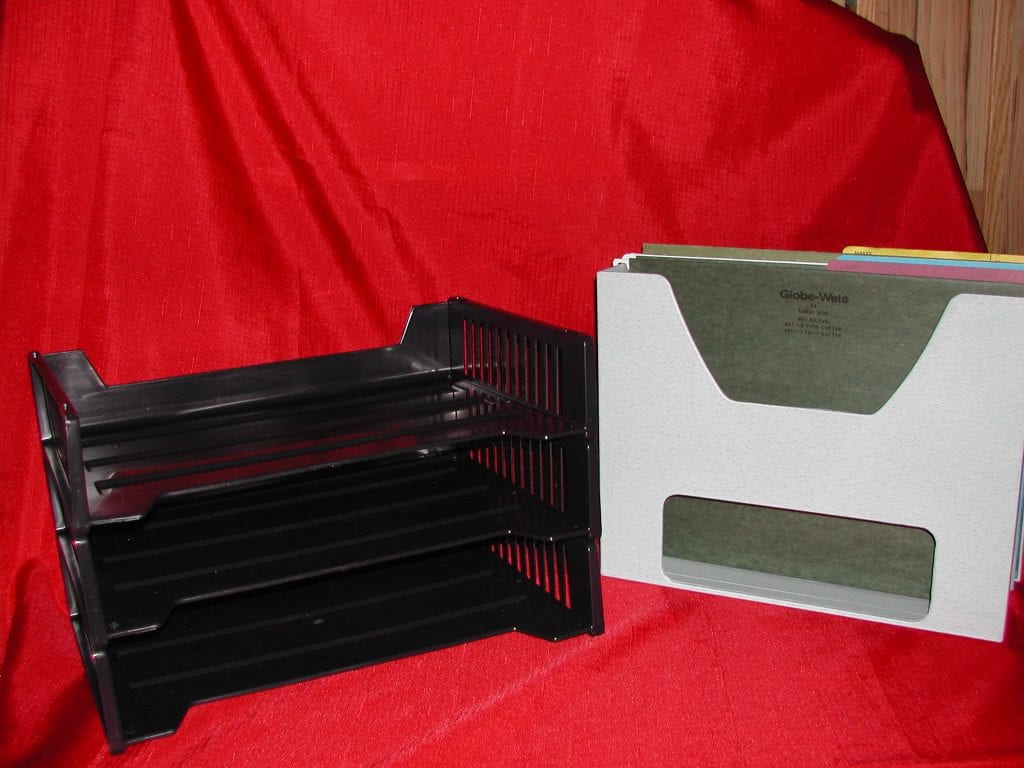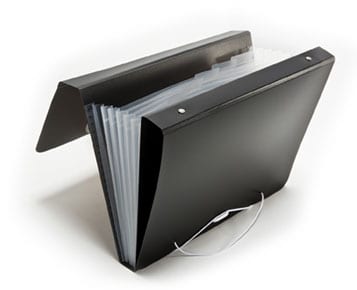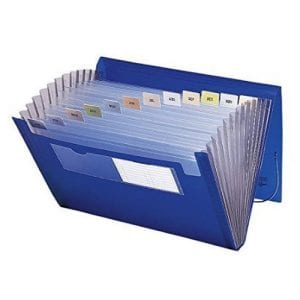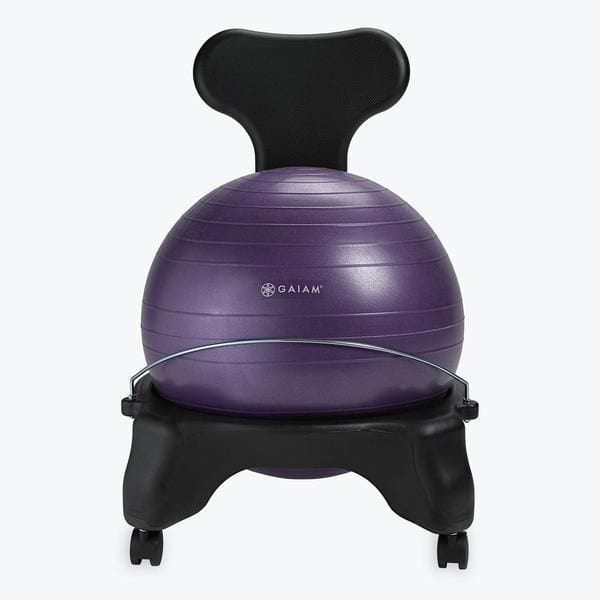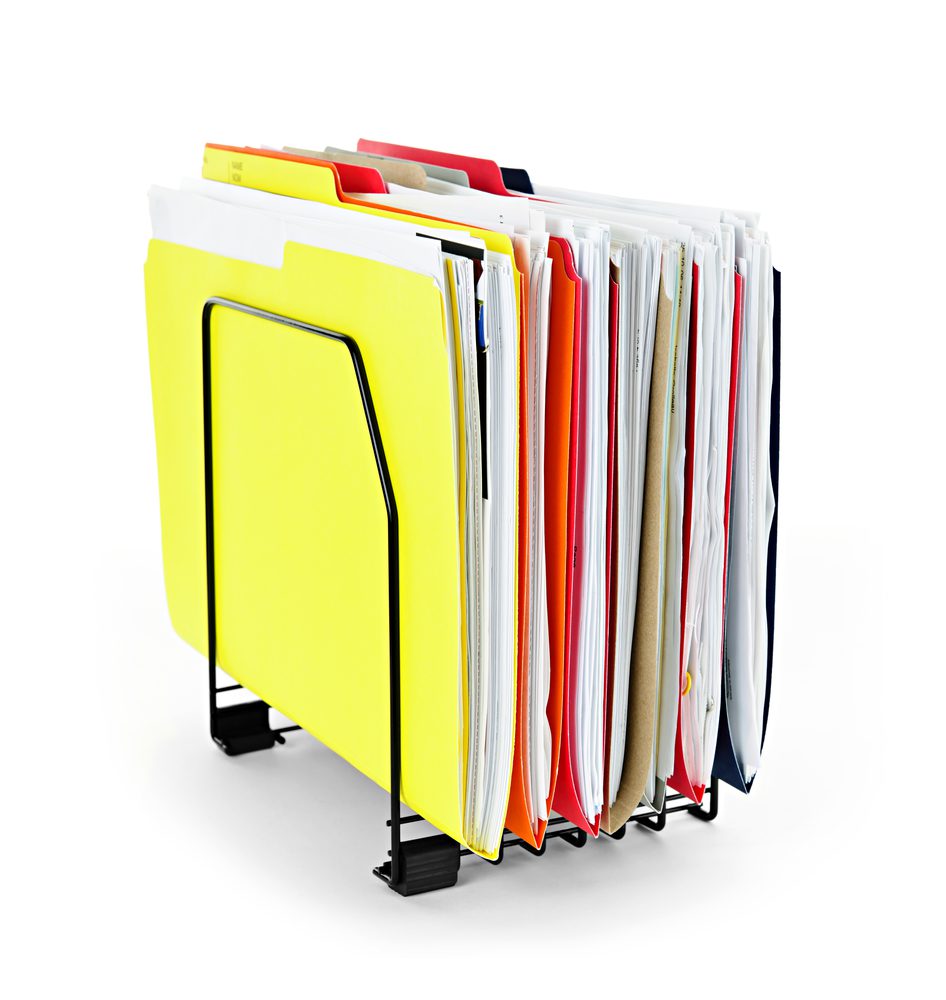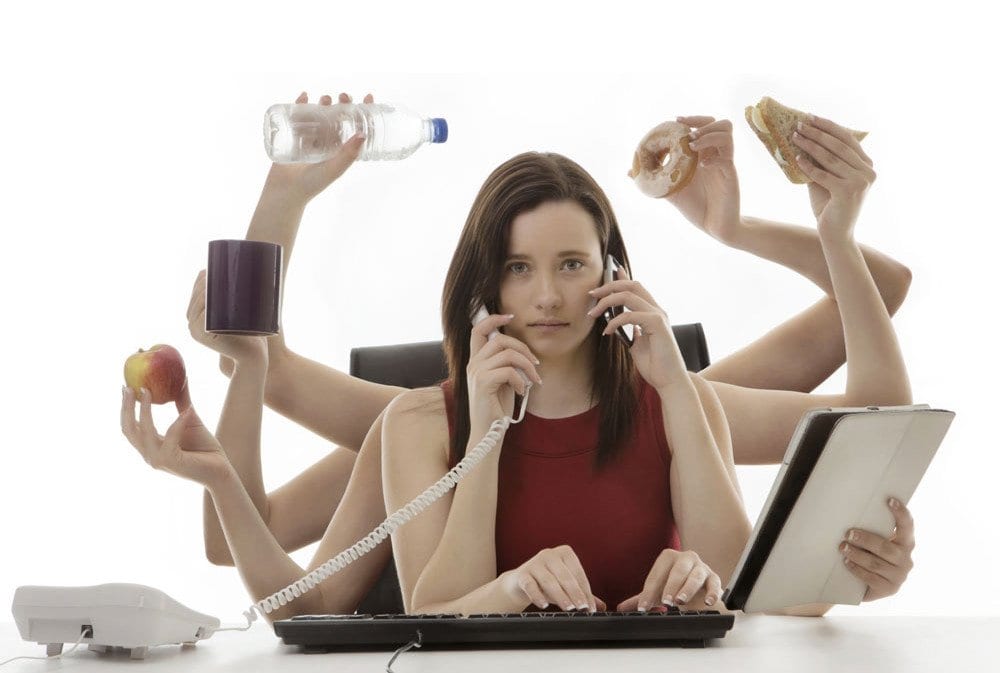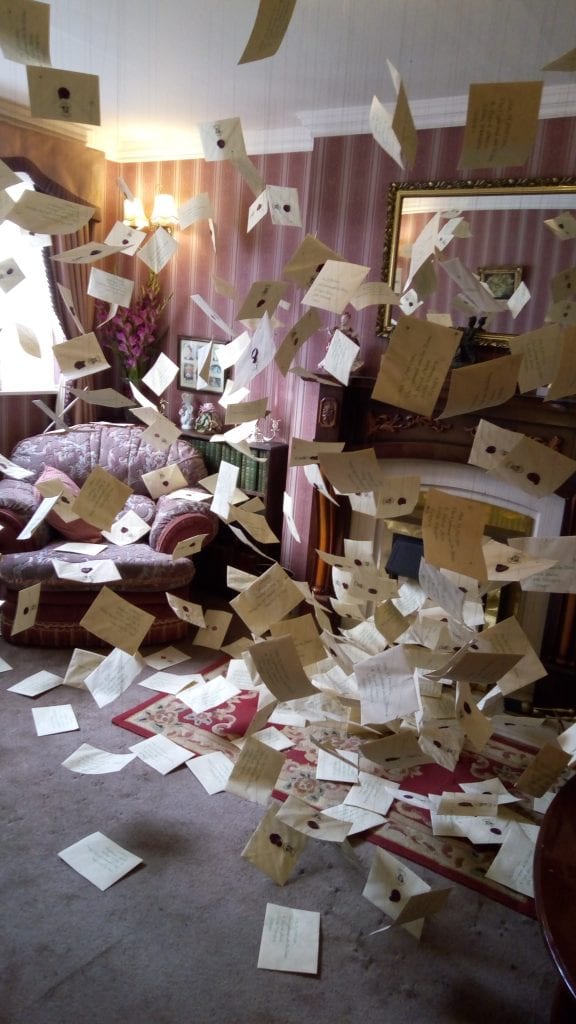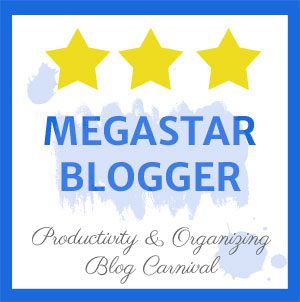Office Organizing
A lovely colleague sent me this first tip. Marie Mushing runs a networking group called People in Connection
1. Make the area a showcase
See what working with a professional organizer can do for you? Professional Organizers rub out junk. Where there was once chaos and huge piles of paper, is now a showcase. Thank you Julie! Replace the junk pile with something pretty as I did, then you won’t want to pile junk on that again. Great motivation to keep the filing done!
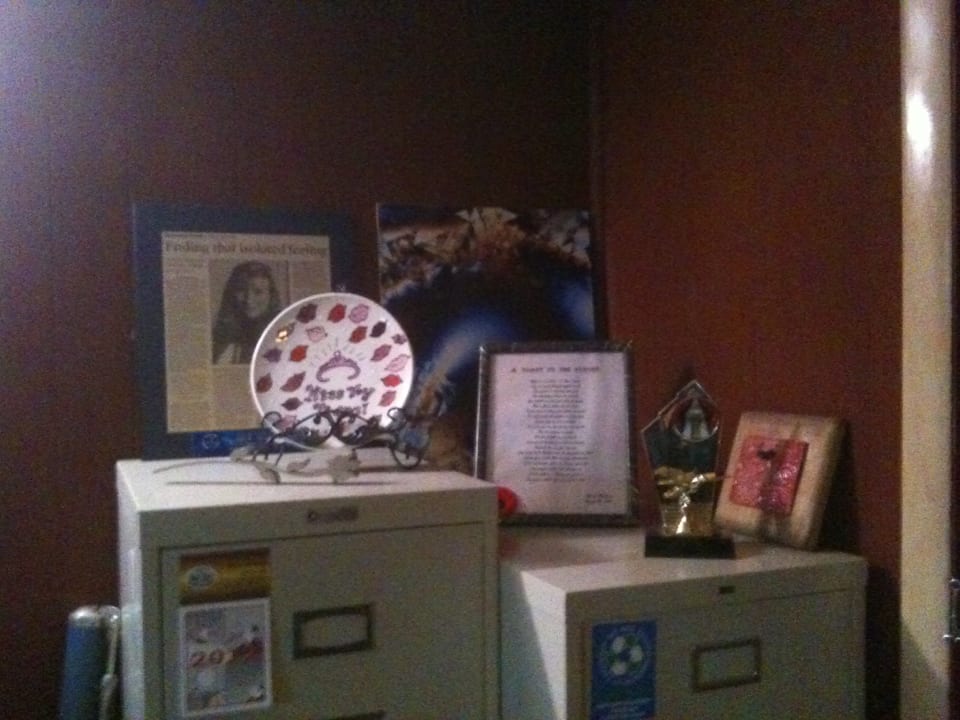
2. Prevent drop zones from forming
If you have an empty flat surface it sometimes calls to people, “to fill me with stuff.” To prevent that area from becoming cluttered, put a large object or two in that spot. It will make the area feel full and then you won’t drop things there. With only 2 larger objects, it is easy to pick them up and dust and clean them. If you use a number of smaller items it may make the area harder to clean.
3. Designate a paper collection spot
Assign a place to put papers that need to be read, filed, signed etc. Place a tray, lovely baskets, eye catching red container etc in a convenient location. Why red? Red is a high energy colour, it increases your heart rate, and your eye is drawn to red items. Using a red basket can help to make dealing with paperwork a high priority activity. Keeping paperwork consolidated in one spot makes it easier to find and work with. When paper is all over the office or house it becomes visual clutter, causing anxiety, the release of cortisol and you feel stress. Cut the visual clutter, collect the paper in one spot, and complete the tasks.
4. Avoid the L word – later
Piles of paper will continue to build up if you leave them for later. Later will never come. Schedule time to deal with paperwork: schedule time to read, file, and reply to paperwork that generates more work. Schedule these activities according to your level of energy at different times of the day. Scheduling reading after lunch at a low energy time of the day may not be productive but scheduling filing after lunch may be perfect because it gets you up and active. Scheduling time at the beginning of each day to concentrate on work generated by email, letters, and documents might work well when you are able to focus on single tasks. Remember not to multitask.
If you’re interested in learning how colour can affect your productivity, this guide is free and you can find it here.
What tricks do you use to help you complete paperwork?
Related articles The truth about multitasking
 Julie Stobbe is a Trained Professional Organizer and Lifestyle Organizing Coach who brings happiness to homes and organization to offices, coaching you virtually using Zoom. She has been working with clients since 2006 to provide customized organizing solutions to suit their individual needs and situations. She uses her love of teaching to reduce clutter, in your home, office, mind and time. She guides and supports you to be accountable for your time, to complete projects and to reach your goals. If you’re in a difficult transition Julie can coach you to break-free of emotional clutter constraining you from living life on your terms. Online courses are available to help instruct, coach and support your organizing projects. Get started by downloading Tips for Reorganizing 9 Rooms.
Julie Stobbe is a Trained Professional Organizer and Lifestyle Organizing Coach who brings happiness to homes and organization to offices, coaching you virtually using Zoom. She has been working with clients since 2006 to provide customized organizing solutions to suit their individual needs and situations. She uses her love of teaching to reduce clutter, in your home, office, mind and time. She guides and supports you to be accountable for your time, to complete projects and to reach your goals. If you’re in a difficult transition Julie can coach you to break-free of emotional clutter constraining you from living life on your terms. Online courses are available to help instruct, coach and support your organizing projects. Get started by downloading Tips for Reorganizing 9 Rooms.
Contact her at julie@mindoverclutter.ca
Twitter – Facebook – Facebook group Organizing Mind and Space
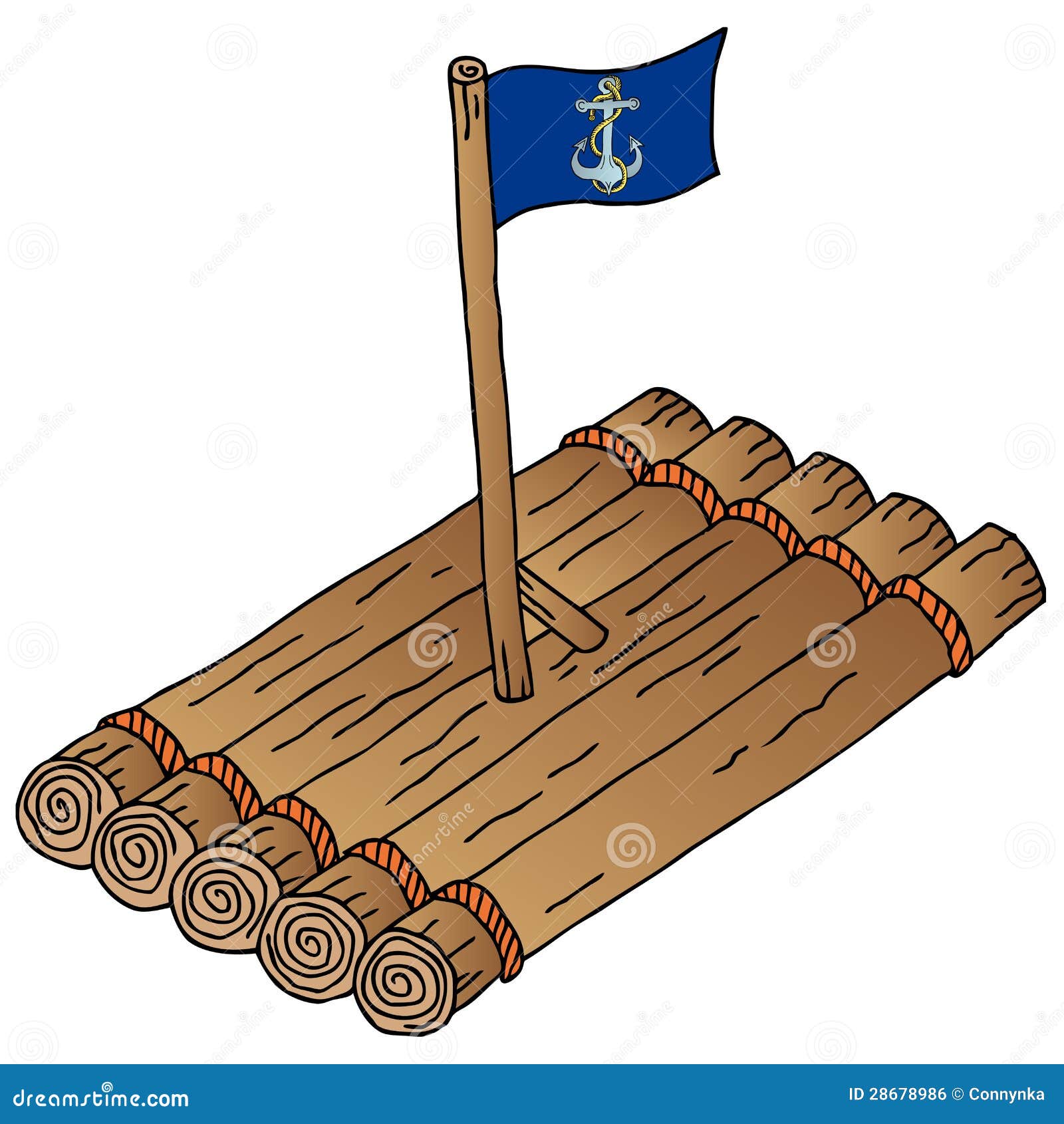

R – Read
A – Act
F – File
T- Toss
Paperwork, e-mail messages and electronic files can overwhelm you making you feel stressed and ineffective. Step one is to open your mail or email. Step 2 is to have a system to process it. If information has built up, look at the creation date on the document and decide if is the most recent version. If the document was replaced by a more current version toss or delete the old versions. If the document can be replicated, retrieved or is obsolete toss it, shred it or delete it.
As documents arrive, paper or electronic decide:
R – Needs to be read or referred to later
If it will be read or referred to another person, place it in a folder (electronic or paper) labelled as read. If the document is to be used by another person forward it to the correct person.
A – Needs to be processed
If the document requires:
- an action to be taken,
- a decision to be made,
- a response conveyed or
- has a deadline
place it in a folder marked Act. Financial documents should have their own folder separate from the Act folder.
F – Needs to be filed
If the documents are completed but must be retained, then they are filed. If it is an electronic document forward it to the correct folder. If it is a paper document place it in a file or basket for filing at a later date.
T – Toss – Needs to be disposed of
Documents that you:
- no longer need,
- have no financial implications,
- are out of date,
- junk mail or
- a copy can be obtained elsewhere
can be tossed, deleted, recycled or shredded.
All of your electronic communications and paperwork are now filed as:
- Read
- Act
- File or
- Tossed
and are ready to be handled at a later time. Schedule time in your agenda/calendar to read documents, complete any action needed on documents and file paperwork. This system helps you to:
- know where documents are if someone has questions,
- allows you to manage your time effectively by scheduling your paperwork at times when you will be uninterrupted and
- be able to quickly locate the papers/documents you need to complete a task.
Although much of your information is paperless there is still a substantial amount of paper to control. Have 3-5 stacking trays or a desktopper with folders. Label the folders/trays: to do, to read, to file, refer to other people, and miscellaneous forms. File the paper correctly and schedule a time to process each folder.
At the end of the day:
- Clean off your desk, leaving only papers you are going to process tomorrow in a stack on your desk.
- In your calendar record the files you need to process. Place e-mails/documents to be worked on in a folder marked with the day of the week they will be processed
- Check your to-do files (paper and electronic) for items that need to be completed the next day
- Sort all other papers and documents into their appropriate trays/ folders.
Share how you prevent emails and paperwork from drowning you.


Contact her at julie@mindoverclutter.ca
Twitter – Facebook – Facebook group Organizing Mind and Space
Many people feel the only way to file paperwork is in a filing cabinet in filing folders. I like to say some people file horizontally using files and something to hold them. While other people use files and stack them vertically. Both types of people are doing the same thing in a different direction. Are you a filer (horizontal hanging files) or are you a piler ( vertically stacking files)? Learn about 5 ways you can keep your paperwork controlled.
1. Traditional Filing Cabinets
They come in many sizes and colours. Make sure to get one with drawer sliders so you can easily reach the back of each drawer. Some come with locks others do not. They can be vertical or horizontal. Horizontal cabinets provide a space to set things on, a printer, a plant etc. You can buy a stand that has wheels to set under the filing cabinet to make it easier to relocate.
2. Binders
Binders are a good solution for visual people. You can have them on a shelf and easily see all your files. The binders can be colour coded to make it simple to find the correct binder. Use dividers, pocket dividers or sheet protectors to file papers. Set up the categories you need: household bills, bank statements, warranties etc. Some binders also have a set of accordion files attached to the binder. Here is a review of this product.
3 Rolling Crates/ File Boxes on Wheels.
Use hanging folders and file folders. The advantage to this is you can take them to whatever room you want and the top is open so you can see the files easily. With the crates, you can stack them for easy storage.
Crates make your files portable
4. Expandable Files
Use one section for each category of paperwork. For example household bills, income tax, financial documents, insurance policies, warranties, etc. They are great to have one for each member of the family to store papers relating to them, report cards/school documents, immunization/health records, passport and other documents, certificates etc. You can also colour code these files.
Some come with special hooks so you can store them in a filing cabinet or crate.
5. Magazine holders
Magazine holders come in paper and plastic. They are available in many colours and patterns. Try to buy ones with solid sides so papers will not get caught and it can be hard to slide in. Use a holder for each category of paper you need to file. You can colour code your systems making it easier to quickly access the files you need. You can turn them so the spines are facing out, and label them, to reduce the visual clutter of seeing all the papers in each box.
What is your preferred method for filing paperwork? Tell me about your system.


Contact her at julie@mindoverclutter.ca
Twitter – Facebook – Facebook group Organizing Mind and Space
Reading time – 3 minutes
Organizing your home office can lead you in many directions. Perhaps:
- your inbox is inundated,
- your files are filled or
- your time management is missing.
You need to start somewhere so let’s start with the S.P.A.C.E. that houses your office.
Look around your office and start:
1. Sorting the items that are visible into groups of papers, books, office supplies, client files, products, advertising materials etc.
Start with the visible clutter first.
2. Pair down each pile with the items that are current and recycle or shred the rest.
3. Assign a convenient place to store your resources. If you use them often keep them near your desk, if they are used infrequently store them further away but still in your office. If they are never referred to but are needed for tax or legal purposes they can be stored in another room.
4. Take each of those piles and select the best Container for keeping the items organized, binders, magazine holders, bins, boxes etc.
Organize with binders
Organize with bins
Organizing for the person who likes to see everything, the visual person
5. Evaluate your new S.P.A.C.E. to make sure it will help you be more efficient, productive and profitable this year.
Share one of your office organizing tips in the comment box.




Contact her at julie@mindoverclutter.ca
Click here to learn more about her online course Create an Organized Home.
Twitter – Facebook – Facebook group Organizing Mind and Space
Reading time: 10 minutes
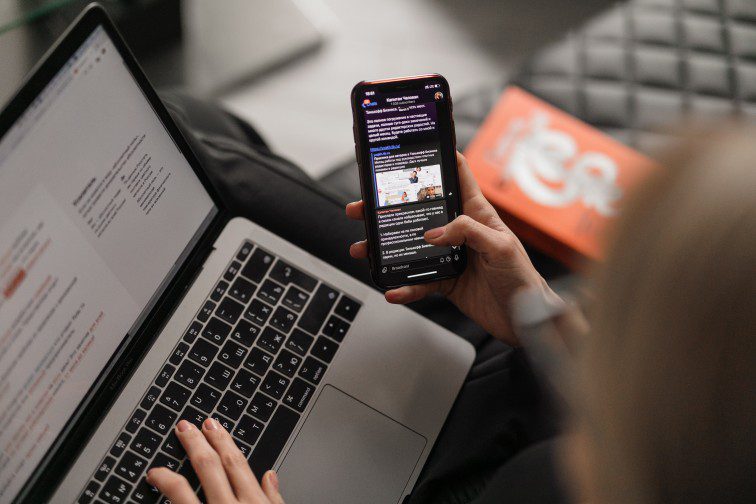

It is no wonder that you are so distracted by e-mail that you can’t get anything done. Here are 5 tips to help you manage your email communications.
1. Turn off the audio reminder of e-mail arriving in your inbox so you won’t be distracted from the task you are trying to complete.
2. Set aside two or three specific times of the day to check your e-mail and respond to quick items with a ‘yes’ or ‘no’. Schedule, in your agenda, longer e-mails to be answered when you have more time.
3. Cut down on those 121 emails by reducing the number of lists and newsletters you subscribe to. They are just like magazines that lie around waiting to be read and create a feeling of stress in you.
4. Keep your inbox as empty as possible by creating folders to store receipts, orders, invitations, information etc. Search functions do work well for finding old emails, leaving them all in your inbox means you spend time re-reading emails.
5. Don’t respond to e-mails from companies and people you don’t know. Don’t respond to any e-mail asking for or giving you money.
The average professional spends 2.6 hours each day on approximately 120 emails. Share on XShare your best tip that helps you use email productively.


Contact her at julie@mindoverclutter.ca
Twitter – Facebook – Facebook group Organizing Mind and Space
Some people’s workspace is for studying, some people work from home, and some attend school virtually. My guest blogger this month is the Custom Writing Team.
According to recent studies, it can take up to twenty minutes to get focused again after getting distracted. Finding and organizing the perfect working/studying space may be the best solution for you.
Proper arrangement of stationery, a comfortable chair and desk, and the absence of clutter and distractions may significantly boost your productivity. Even the colour of your walls and accessories impacts the learning process too!
To help you organize your workspace, we have prepared nine great tips, outlined in the infographic below. Check it out and make your room comfortable and inspiring!


Infographic by Custom-Writing.Org
Did Custom-Writing miss anything? Comment on what you would add as tip number 10.
If you need help creating, redesigning or organizing your work/study space contact julie@mindoverclutter.ca


Contact her at julie@mindoverclutter.ca
Twitter – Facebook – Facebook group Organizing Mind and Space
With more people working from home, it is a good time to look at your office design. When I started organizing in 2006 I learned about organizing efficient offices so you didn’t waste time away from your desk. Starting in 2014 new research was telling us to organize offices to help you be active. Stand up, sit less and move more. Share on X
Even the most well-designed office can make you feel chained to your desk. Make sure that you can get up and take a walk occasionally, or maybe move to a secondary location where you get a little work done without sitting in the same place all day.
Organize an Active Workstation
Stand up Sit less Move more
An active office is defined “as a workplace design concept that proposes an integrated supportive environment, which aims at the reduction of sedentary behaviours and promotion of physically active work processes that are characterized by regular changes between different work-related tasks, workstations, and working postures.” Try adding to your traditional desk, elements such as active seats, standing desks, and whiteboards to help you get moving.
Products that make your office active
Use an exercise ball as your chair. You constantly contract and release muscle tension to help your balance. This muscle contraction helps you to be more active and less sedentary.
Invest in a sit stand desk. They are very economical and allow you to transition from sitting to standing as you change the type of work you are doing. It is the transition from sitting to standing and standing to sitting every 30 minutes that gives you the health benefits associated with an active office design.
Make a larger investment and buy a treadmill desk. It allows you to walk while working.
There are many more products you can use in your office.
Health benefits of an active office design
Studies are showing that it is transitioning from one position to another that is good for your health; it activates muscle contraction and circulation.
Studies suggest that transitions between sitting and standing be made every 30 minutes.
This is a link to a great article http://mi-lab.org/files/2012/02/ActiveOffice-final.pdf
If you need a virtual presentation on this topic for your staff that is working from home, contact me.


Contact her at julie@mindoverclutter.ca
Twitter – Facebook – Facebook group Organizing Mind and Space
-
Psychological properties of colours
Before applying a colour-coded system to the office, learn the meaning behind popular colours to help dictate which hues to use and when.
- Red: Associated with energy and power, red is an intense colour. Since it quickly grabs the eye, use it to alert coworkers of something urgent.
- Orange: Less aggressive than red, orange is still an eye-catching, dominating colour. A hue closer to the shade of gold can mean luxury, wisdom, or wealth. Use it to label new or long-term projects that focus on the future or improving your business.
- Yellow: Also a great attention grabber, yellow signifies happiness, hope, and positivity and is commonly used for important items that cannot be ignored. Use it for production tasks or to communicate new ideas.
- Green: A symbol of growth and fertility, green symbolizes stability and healing power. Use it for financial tasks and environmental initiatives.
- Blue: As a calming colour, blue represents loyalty, intelligence, and focus. It’s also a trusting colour. Use it for brainstorming, presenting, and networking.
- Purple: A combination of blue and red, purple is a creative colour that symbolizes royalty and luxury. It’s great for creative tasks.
- Pink: A playful colour, pink is full of compassion. It’s a loving, intimate, and feminine colour. Save it for personal labels and special occasions.
- White: Associated with purity, white signifies success and perfection. Use it to signify simplicity and cleanliness.
- Black: A formal colour, black can be prestigious or authoritative. Use it to make other colours stand out and for formal events.

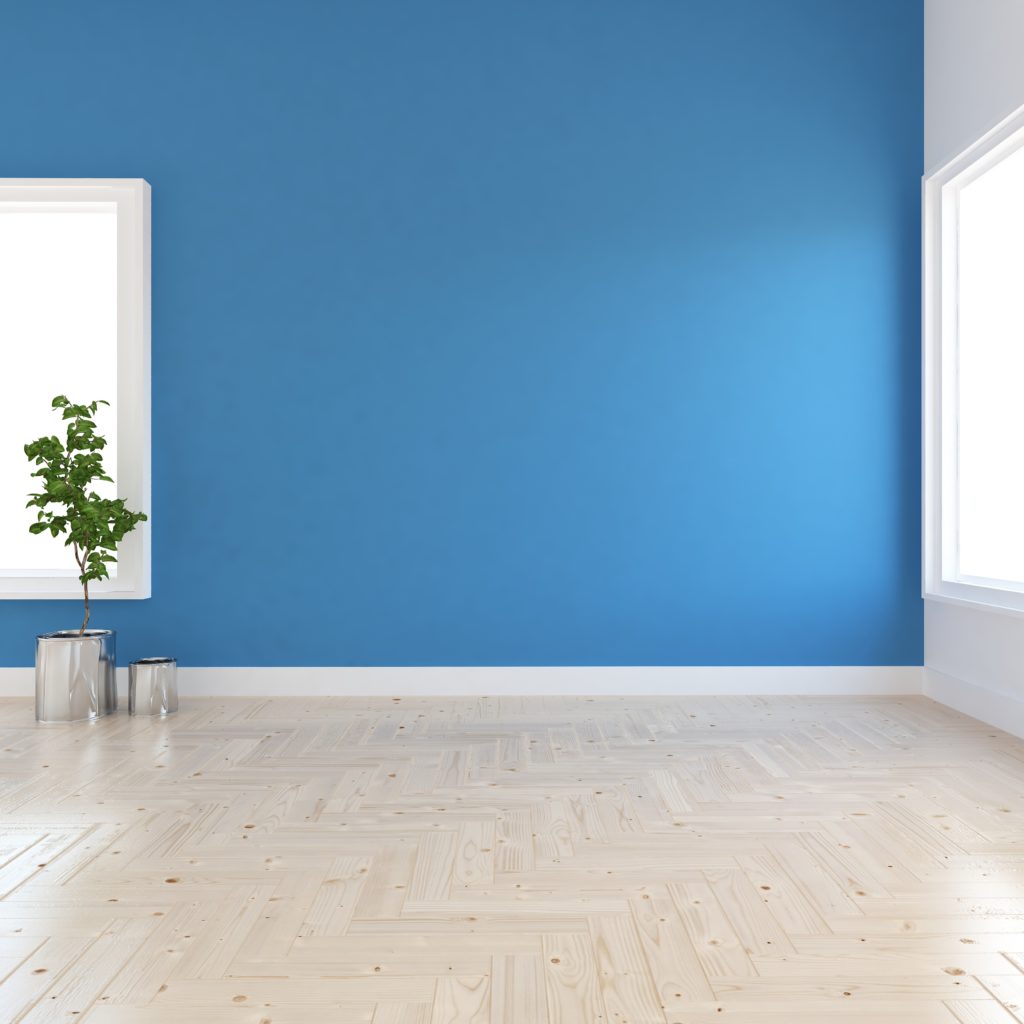
-
Organizing files by colour
When it’s necessary to save every piece of paper that touches your desk, it can be easy to misplace important information in a pile of white. To file papers you may need to reference later, create a color-coded system with folders.
Divide documents into categories—invoices, tax documents, office guidelines, etc.—and choose a colour to represent each category. Use folders or tabs in each designated colour to organize the categories. For file cabinets, choose an assortment of colored hanging folders, which are sturdy enough to hold most documents.
When passing documents between teams, it’s a good idea to assign colours to departments or tasks. Colored file folders help distinguish which documents need to head to the HR department or be reviewed by the financial team. If using plain manila folders, stick colored labels or tabs on each folder.
Multiple projects can be assigned a colour and organized in three-ring binders. Maintain the colour-coded system inside the binder to separate budget and creative documents.
If it’s time to archive documents, use storage bins in the colour-coded system to quickly identify what is inside.Colour psychology is the study of hues to determine the effects on human behaviour. It can be applied to many things in life like office organizing and productivity. Share on X
-
Colour code your calendar
A calendar filled with back-to-back meetings can be overwhelming and ineffective. Ease the stress by assigning colors to events—both work and personal—to get a better understanding of your day-to-day activities. Visualizing the events can help control how much time you allocate to each activity or project.
To categorize meetings, choose colors based on their psychological properties. Most calendar apps allow users to assign colours, but if you prefer traditional day planners, use sticky notes or coloured pencils to categorize.
- Red: Wednesday 11 a.m.—” Final Spreadsheet due”
- Blue: Tuesday 3 p.m. — “Brainstorm Session w/ PR”
- Green: Thursday 10 a.m. — “Budget Meeting”
- Yellow: Tuesday 9 a.m. — “Credit Card Bill Due” Wednesday 1 p.m. — “Order File Folders”
- Purple: Monday 2 p.m. — “Present Sales Pitch” Thursday 1 p.m. — “Review Mock-Ups”
- Pink: Friday 5 p.m. — “Happy Hour”
-
Take notes in colour
Writing notes on paper is a great concept—until those notes get lost among other notes and are never read again. Take the colour-coded calendar a step further by using the same coloured pen to take notes. Colour coding can also stimulate different parts of your brain and allow you to see connections previously overlooked.
In a budget meeting? Use a green pen to jot down notes. If a creative idea comes to mind that you don’t want to forget to bring up during a weekly brainstorming, use purple. When you flip back through your note pages, the system will allow you to quickly find what you’re looking for. But avoid too much color—if everything is highlighted, it’s difficult to tell what takes priority.
-
Colour code your inbox
If hundreds of unread emails leave you overwhelmed, assign colors to senders or subjects to quickly identify what needs attention. Many email systems have settings to adjust how emails are displayed in your inbox. Assign automatic colours to specific people, such as your manager, so those emails will stand out.
Messages can also be coded by subject line. If you’re working on a specific project, assigning that project name a colour will separate it from everyday emails.
Conclusion
Colour coding is meant to make your work life easier. Assign colours before you start a new project and limit the amount to avoid confusion. You shouldn’t have to spend time deciphering your colour code!
How do you use colour coding to keep yourself organized?




Contact her at julie@mindoverclutter.ca
Twitter – Facebook – Facebook group Organizing Mind and Space
Here is a short excerpt from an article by Harold Taylor. Harold Taylor is a time management and productivity expert.
Change your environment in some way to offset your natural inclination to avoid doing things you don’t like.
You can minimize distractions:
- turn off your cell phone,
- disengage voicemail,
- turn off email alerts and
- close your office door at specific times while you work on your priority projects.
You can minimize visual distractions:
- remove all clutter and other potential distractions from your immediate work area
- including any in-baskets, they give you an excuse to chat with the person dropping off paper
- don’t have family photos or memorabilia in your line of sight
- face a blank wall, not a window or open doorway.
You can set up a work schedule:
- Work on projects for 60 or 90 minutes at a time – maximum.
- Then change to another type of work for 15 minutes
- Work on a project for 60-90 minutes
- Then take a 30 minute break, doing something completely different from your previous work
- Work for 60 more minutes on a project
If you find that’s too long to postpone urges to interrupt yourself, shorten the work sessions. You can always increase them gradually later. Between sessions, you can check email, return phone calls and grab a coffee. Work in short sprints rather than attempt marathons. Research shows that it takes a lot of energy to practice willpower.
Resist the temptation to interrupt yourself
Do what you can to develop a work environment that makes it easier to resist the temptation of interrupting yourself or others, checking email constantly, grabbing for your smartphone whenever there’s a call or being distracted by other things.
To subscribe to his monthly newsletter on Time Management go to www.taylorintime.com


Contact her at julie@mindoverclutter.ca
Twitter – Facebook – Facebook group Organizing Mind and Space
We use 20% of the stuff we own. Keep the 20% of paper that is important and discard the other 80% . Share on X
1. Don’t allow paper to build up
- Handle paper daily, don`t let it grow into a pile
- Place all paper in one location, don’t let it travel all over the home
- Open mail and discard the envelop and advertising
- Schedule a time to file, make calls, pay bills etc
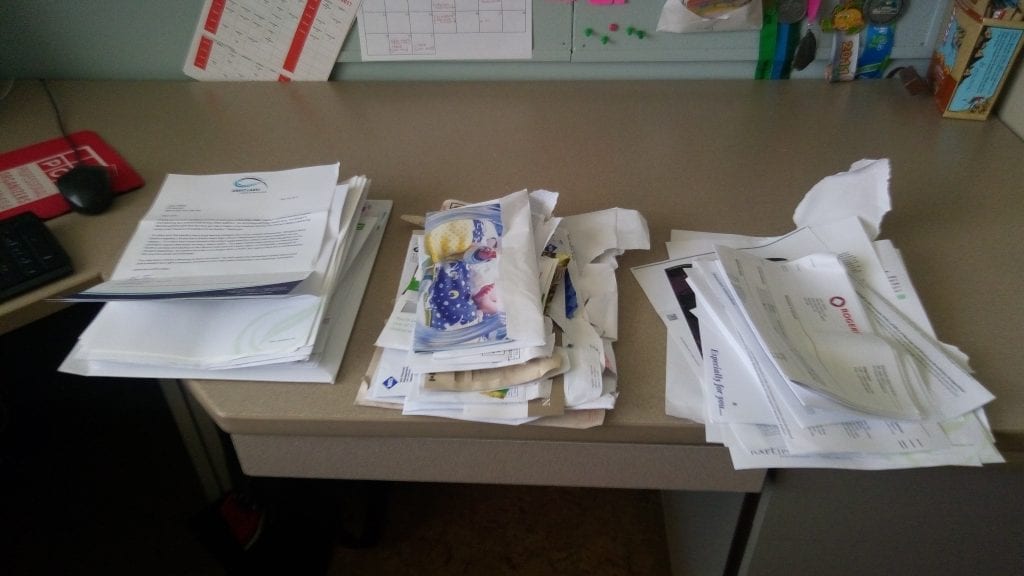
2. Make a decision on each paper the first time you touch it
- If it can be done in 60 seconds or less do it now, otherwise R.A.F.T it
- Set up 3 files, bins or trays and sort your paper into:
- R – read later
- A – action required
- F – file
- T – toss it / shred it now
3. Follow through on work
- Each time you pick a sheet of paper put a small dot on the top corner.
- Three dots or more means it is time to take action on that piece of paper.
- If you are procrastinating about what to do, it probably means you are not sure how to solve the problem in the paperwork. Ask for advice, designate it to someone else, research the issue or break it into smaller parts you can complete.
4. Be ruthless
- 80% of what is filed is never accessed again, so 80% or more of the paper you receive on a daily basis can be discarded
- Clear out your files once or twice a year
- Remove yourself from subscription lists
5. Think before you print
- File e-mails in a folder on the computer
- Print only the selection of the e-mail or webpage you need
6. Store inactive files in boxes indicating a destroy date
7. Follow retention guidelines
- Retain files as specified by your company or accountant
- Put inactive files in boxes and place them in storage indicating a destroy date on the box
- Clear out outdated files
For more great office organizing ideas read “Don’t Agonize Organize Your Office” by Diane A Hatcher
If you need help with your paper organizing book a complimentary discovery organizing session with me. Organizing Session


Contact her at julie@mindoverclutter.ca
Twitter – Facebook – Facebook group Organizing Mind and Space
